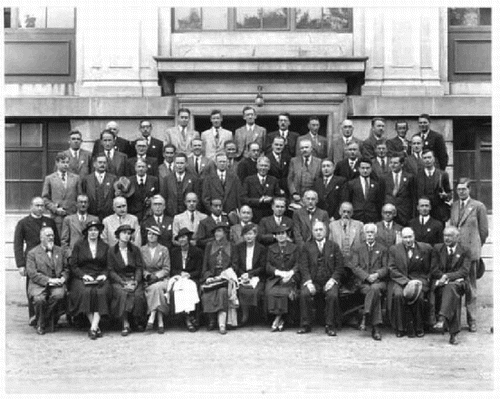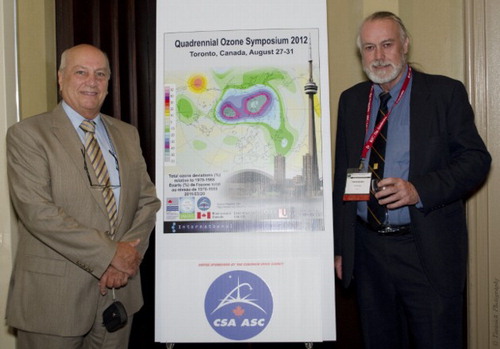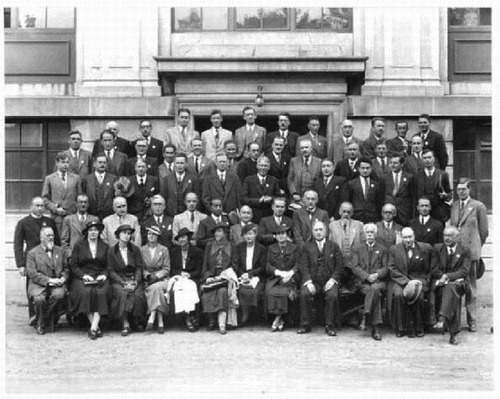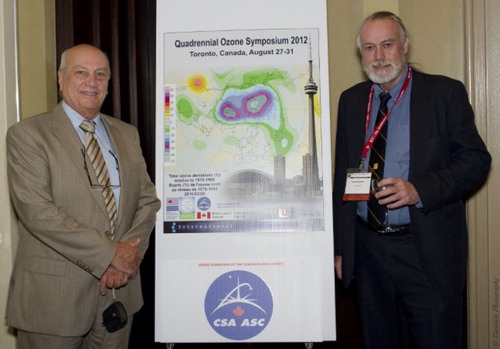1 Background
The twenty-second Quadrennial Ozone Symposium (QOS) was held in Toronto in August 2012, a year that marked a number of anniversaries of events related to the study of ozone and connected to Canada. These include the 50-year anniversary of the founding of the World Ozone Data Centre (now the World Ozone and Ultraviolet radiation Data Centre; WOUDC) by Environment Canada scientist Carleton Mateer; the 30-year anniversary of the delivery of the first commercial Brewer Ozone Spectrophotometer to Thessaloniki in Greece; the 25-year anniversary of the signing of the Montréal Protocol on Substances that Deplete the Ozone Layer (a protocol to the Vienna Convention for the Protection of the Ozone Layer) in Montréal; and the 20-year anniversary of the introduction of the Ultraviolet (UV) Index in Canada. These anniversaries speak to the strong commitment that Canada has had to ozone measurement and ozone science.
The twenty-second symposium is also notable for another reason—it was the first QOS to take place after the discovery of the first Arctic ozone hole (Manney et al., Citation2011). A number of papers were presented addressing that event. The QOS2012 saw nearly 300 scientists and students come together to share their research in Toronto. Attendees from 30 countries contributed more than 200 abstracts; 213 posters and 105 oral talks were presented. There are 15 papers in this special issue of Atmosphere-Ocean.
2 History of the ozone symposium
The QOS has a long history; the first meeting was held in Paris in 1929. The second meeting was held in 1936 in Oxford, England, and was hosted by Gordon Dobson. is a group photograph from the 1936 meeting. Many of the names of people in the photograph have become familiar to anyone who studies ozone. lists the meetings and their locations as derived from the report of Rumen Bojkov (Citation2010) and the website of the International Ozone Commission (IOC; http://ioc.atmos.illinois.edu/). The IOC played an important role, working with the World Meteorological Organization (WMO) and the United Nations Environment Programme (UNEP), in the creation of the international ozone assessment process.
Fig. 1 This group photo was taken at the second ozone symposium in Oxford England in 1936. Many of the names of people in the photograph such as Dobson, Chapman, and Götz are now well known to anyone working in the field (photograph from the Oxford University archive contributed by Charles Welch (University of Oxford, Citation2014)).

Table 1. Quadrennial Ozone Symposia.
3 Ground-based ozone observations
It was a personal pleasure for me, after working in the ozone field for over 40 years, to have the opportunity to host the QOS in Toronto, the home of Environment Canada's ozone monitoring program. A number of the papers presented at QOS2012 presented data from the use of Brewer Ozone Spectrophotometers. The development of the “Brewer” is a Canadian story and also a Toronto story. In the 1960s, David Wardle, as a graduate student under the supervision of Desmond Walshaw at Cambridge University in England, developed a two-channel diffraction grating spectrophotometer that he used to take measurements of ozone using starlight during the polar winter at Resolute Bay in the Canadian Arctic. After completing his Ph.D., he went to work with Alan Brewer at the University of Toronto. Together with Brewer, he pursued the design of a multi-wavelength spectrophotometer to measure ozone. James Kerr and the author worked with Brewer and Wardle and continued developing the instrument after Wardle left for a position at Macdonald College in Montréal. By 1975 Kerr, Wardle, and the author were all working at the Atmospheric Environment Service of Environment Canada (EC) in Toronto. In the late 1970s, WMO requested that the department pursue the commercial development of the spectrophotometer as a replacement for the Dobson Ozone Spectrophotometers in the global ozone network.
A Canadian company called Sci-Tec Instruments Inc. in Saskatoon, Saskatchewan, was selected by competition to manufacture the instrument for commercial sale. Three instruments were constructed in 1982 with the first, instrument #005, going to Greece. The instrument was acquired by the Laboratory of Atmospheric Physics at the University of Thessaloniki, led by Prof. Christos Zerefos, now president of the IOC. The author and professor Christos Zerefos are shown in ; the photograph was taken at QOS2012. Once the first three Brewers were in service, a design modification was made to allow the instrument to measure global UV radiation. This led to the development of the UV Index and the UV Index forecast at EC, which were introduced in 1992. Brewers are now made by Kipp & Zonen B.V. of Delft, the Netherlands. The role of the more than 200 Brewers in the global observing system was well-represented at QOS2012.
Fig. 2 Professors Christos Zerefos and Tom McElroy at the 2012 Quadrennial Ozone Symposium. McElroy delivered the first Brewer manufactured, #005, to Thessaloniki in 1982 (photo courtesy of Tarasick Photography).

Of course the Brewer is not the only ground-based measurement device nor is it the most important. Dobsons, LIDAR, filter instruments, ozonesondes, and remote-sounding measurements from space all play an important role in maintaining a global picture of the ozone layer. Papers representing all these measurement techniques are part of each Symposium.
4 The importance of the ozone community
The QOS has long been an essential vehicle for advancing ozone science internationally. It has informed the members of the IOC and allowed it to influence the WMO and governments around the world. It led to the 1985 agreement in principle to pursue the development of an international treaty to protect the ozone layer from the destructive potential of ozone-depleting substances, notably chlorofluorocarbons. The Vienna Convention for the Protection of the Ozone Layer was the first outcome of that meeting. It was followed by the Montréal Protocol on Substances that Deplete the Ozone Layer, which was signed in Montréal in September, 1987. Now, 25 years later, it is clear that the Protocol and its amendments have limited the damage from ozone-depleting substances and stabilized the ozone layer. The protocol has successfully limited the release of ozone-depleting substances to levels low enough to enable the eventual recovery of the ozone layer to its former state.
The Montréal Protocol is a sterling example of the power that science and international efforts can have in protecting the environment and altering our behaviour if properly coordinated. It provides hope that our response to other serious challenges, such as climate change, will be equally successful. It also provides the lesson that sound science is essential for guiding the changes needed in society to safeguard our future. The Protocol demonstrates that the economy, as well as individual corporations, can survive regulation, provided that controls are introduced in a way that permits long-term planning and a level playing field for industries around the world.
This special issue celebrates the ongoing contribution to society made by the IOC and the ozone research community and underlines the need to continue monitoring the ozone layer and meeting to exchange information and promulgate knowledge. The ozone community now clearly recognizes the importance of keeping researchers who use ground-based and satellite-based sensors mutually informed and cooperating with each other to provide the best quality global dataset. I would like to acknowledge the important contributions of the associate editors: Jacek Kaminski, Ian McDade, Chris McLinden, Kimberly Strong, and David Tarasick. Until 2016 in Edinburgh, Scotland!
Acknowledgements
The author's work is supported by funding for the CSA/ABB/NSERC Industrial Research Chair in Atmospheric Remote Sounding (NSERC File #413012).
1 Toile de fond
Le Vingt-deuxième Symposium quadriennal sur l'ozone (SQO) s'est tenu à Toronto en août 2012, une année qui a marqué l'anniversaire de plusieurs événements liés à l’étude de l'ozone et auxquels le Canada a participé. Parmi ceux-ci, mentionnons le 50e anniversaire de la fondation du Centre mondial des données sur l'ozone (aujourd'hui le Centre mondial de données sur l'ozone et le rayonnement ultraviolet — WOUDC) par le scientifique canadien Carleton Mateer, d'Environnement Canada; le 30e anniversaire de la livraison du premier spectrophotomètre Brewer commercial pour la mesure de l'ozone à Thessaloniki, en Grèce; le 25e anniversaire de la signature du Protocole de Montréal relatif à des substances qui appauvrissent la couche d'ozone (un protocole de la Convention de Vienne pour la protection de la couche d'ozone) à Montréal; et le 20e anniversaire de l'introduction de l'indice ultraviolet (indice UV) au Canada. Ces anniversaires témoignent du ferme engagement du Canada à l’égard de la mesure de l'ozone et de la science de l'ozone.
Le Vingt-deuxième Symposium est également remarquable pour une autre raison : c'est le premier SQO a avoir lieu après la découverte du premier trou dans la couche d'ozone dans l'Arctique (Manney et al., Citation2011). Un certain nombre d'articles traitant de cet événement ont été présentés. Au SQO de 2012, près de 300 scientifiques et étudiants se sont réunis à Toronto pour discuter de leurs recherches. Des participants de 30 pays ont apporté une contribution de plus de 200 résumés; 213 affiches et 105 exposés oraux y furent présentés. Il y a 15 articles dans ce numéro spécial d’Atmosphere-Ocean.
2 Histoire du symposium sur l'ozone
Le SQO a une longue histoire. Le premier s'est tenu à Paris en 1929. La seconde réunion a eu lieu en 1936 à Oxford, en Angleterre, accueillie par Gordon Dobson. La est une photographie de groupe de la réunion de 1936. Le nom de plusieurs des personnes présentes sur la photo est devenu familier pour tous ceux qui étudient l'ozone. Le donne la liste des réunions et des endroits où elles ont eu lieu, selon le rapport de Rumen Bojkov (Citation2010) et le site Web de la Commission internationale de l'ozone (CIO – http://ioc.atmos.illinois.edu/). La CIO a joué un rôle important, de concert avec l'Organisation météorologique mondiale (OMM) et le Programme des Nations Unies pour l'environnement (PNUE), dans la création du processus international d’évaluation de l'ozone.
Fig. 1. Cette photographie de groupe a été prise lors du deuxième symposium sur l'ozone à Oxford, en Angleterre, en 1936. Le nom de plusieurs des personnes présentes sur la photo, comme Dobson, Chapman et Götz, est maintenant bien connu de tous ceux qui étudient l'ozone (photographie tirée des archives de l'Université d'Oxford, fournie par Charles Welch (University of Oxford, Citation2014)).

Tableau 1. Symposiums quadriennaux sur l'ozone.
3 Observations de l'ozone à partir du sol
Ce fut un réel plaisir pour moi, après avoir travaillé dans le domaine de l'ozone pendant plus de 40 ans, d'avoir la chance d'accueillir le SQO à Toronto, port d'attache du programme de surveillance de l'ozone d'Environnement Canada. Certains des articles soumis au SQO2012 présentaient des données obtenues en utilisant des spectrophotomètres Brewer de mesure de l'ozone. La mise au point du « Brewer » est une histoire canadienne et aussi une histoire Torontoise. Durant les années 1960, David Wardle, un étudiant diplômé, sous la supervision de Desmond Walshaw, de l'Université de Cambridge, en Angleterre, a mis au point un spectrophotomètre à réseau de diffraction à deux canaux qu'il utilisa pour obtenir des mesures d'ozone à partir de la lumière des étoiles durant la nuit polaire à Resolute Bay, dans l'Arctique canadien. Après avoir terminé son doctorat, il est allé travailler avec Alan Brewer à l'Université de Toronto. Avec Brewer, il a travaillé à la conception d'un spectrophotomètre multilongueur d'onde pour mesurer l'ozone. James Kerr et l'auteur ont travaillé avec Brewer et Wardle et ont continué à le mettre au point après que Wardle eut quitté pour un poste au Collège Macdonald, à Montréal. En 1975, Kerr, Wardle et l'auteur travaillaient tous au Service de l'environnement atmosphérique, d'Environnement Canada (EC), à Toronto. Vers la fin des années 1970, l'OMM a demandé que le ministère s'efforce de produire une version commerciale du spectrophotomètre pour remplacer les spectrophotomètres Dobson de mesure de l'ozone du réseau mondial de mesure de l'ozone.
Une compagnie canadienne appelée Sci-Tec Instruments Inc., de Saskatoon, en Saskatchewan, a été sélectionnée par appel d'offres compétitif pour fabriquer l'instrument en vue de sa vente commerciale. Les instruments ont été construits en 1982 et le premier, l'instrument no 005, est allé à la Grèce. L'instrument a été acheté par le Laboratoire de physique atmosphérique de l'Université de Thessaloniki, à l'initiative du professeur Christos Zerefos, aujourd'hui président de la CIO. L'auteur et le professeur Christos Zerefos apparaissent sur la ; la photographie a été prise durant le SQO2012. Après la mise en service des trois premiers Brewers, une modification dans la conception fut apportée pour permettre à l'instrument de mesurer le rayonnement UV global. Cela conduisit à mise au point de l'indice UV et à la prévision de l'indice UV à EC, qui furent introduits en 1992. Les Brewers sont maintenant fabriqués par Kipp & Zonen B.V., de Delft, aux Pays-Bas. Le rôle des plus de 200 Brewers dans le système mondial d'observation était bien en évidence au SQO2012.
Fig. 2. Professeurs Christos Zerefos et Tom McElroy au Symposium quadriennal sur l'ozone de 2012. McElroy a livré le premier Brewer fabriqué, portant le no 005, à Thessaloniki, en 1982 (photographie gracieuseté de Tarasick Photography).

Bien sûr, le Brewer n'est pas le seul appareil à pouvoir mesurer l'ozone à partir du sol et n'est pas le plus important d'entre eux. Les Dobsons, LIDAR, instruments à filtre, sondes d'ozone et mesures de télésondage depuis l'espace jouent tous un rôle important en fournissant une image planétaire de la couche d'ozone. Des articles concernant toutes ces méthodes de mesure ont été présentés à chacun des symposiums.
4 Importance de la communauté de l'ozone
Le SQO a longtemps été un véhicule essentiel pour l'avancement de la science de l'ozone à l’échelle internationale. Il a informé les membres de la CIO et a permis à celle-ci d'influencer l'OMM et les gouvernements de par le monde. Il a mené à l'entente de principe de 1985 visant à établir un traité international pour protéger la couche d'ozone du pouvoir destructeur des substances pouvant détruire l'ozone, notamment les chlorofluorocarbones. La Convention de Vienne pour la protection de la couche d'ozone a été le premier résultat de cette réunion. Elle a été suivie par le Protocole de Montréal relatif à des substances qui appauvrissent la couche d'ozone, signé à Montréal en septembre 1987. Aujourd'hui, 25 ans plus tard, il est clair que le Protocole et ses modifications ont limité les dommages des substances qui appauvrissent la couche d'ozone et stabilisé la couche d'ozone. Le Protocole a réussi à limiter le rejet de substances appauvrissant la couche d'ozone à des niveaux assez bas pour permettre l’éventuel rétablissement de la couche d'ozone jusqu’à son état antérieur.
Le Protocole de Montréal est un bel exemple de ce que la science et les efforts internationaux peuvent faire pour protéger l'environnement et modifier notre comportement s'ils sont correctement coordonnés. Il suscite l'espoir que notre réponse à d'autres enjeux importants, comme le changement climatique, sera aussi fructueuse. Il donne aussi cette leçon que des connaissances scientifiques approfondies sont essentielles pour guider les changements à apporter à la société pour garantir notre avenir. Le Protocole fournit la preuve que l’économie, tout comme les entreprises, peut survivre à la réglementation, pourvu que des contrôles soient mis en place de façon à permettre une planification à long terme et des règles du jeu équitables pour les industries partout dans le monde.
Ce numéro spécial célèbre l'engagement continu de la CIO et de la communauté de recherche sur l'ozone envers la société et souligne la nécessité de continuer à surveiller la couche d'ozone et de se réunir pour échanger des informations et diffuser la connaissance. La communauté de l'ozone reconnaît maintenant d'emblée l'importance de voir à ce que les chercheurs qui utilisent des capteurs au sol ou satelliportés se tiennent mutuellement informés et coopèrent pour fournir l'ensemble de données mondiales de la meilleure qualité possible. Je veux remercier les contribuations importantes des directeurs scientifiques associés : Jacek Kaminski, Ian McDade, Chris McLinden, Kimberly Strong, et David Tarasick. Rendez-vous en 2016 à Édimbourg, en Écosse!
Remerciements
Le travail de l'auteur bénéficie du support financier pour la Chaire de recherche industrielle ASC/ABB/CSNRG en télédetection atmosphérique (dossier #413012).
Références
- Bojkov, R. D. (2010). The International Ozone Commission (IO3C): Its history and activities related to atmospheric ozone. Research Centre for Atmospheric Physics and Climatology, Academy of Athens, Publication No. 18.
- Manney, G. L., Santee, M. L., Rex, M., Livesey, N. J., Pitts, M. C., Veefkind, P., … Zinoviev, N. S. (2011). Unprecedented Arctic ozone loss in 2011. Nature, 478, 469–475. doi:10.1038/nature10556
- University of Oxford. 2014. The virtual Dobson room. Extrait de http://www2.physics.ox.ac.uk/research/atmospheric-oceanic-and-planetary-physics/history
Cover: The poster for the 2012 Quadrennial Ozone Symposium. It is a melding of a satellite view of the first Arctic ozone hole and the skyline of Toronto. The 2012 Symposium was the first to be held after the appearance of the Arctic ozone hole (ozone map from Environment Canada; artwork by the University of Toronto).
Couverture: L'affiche du Symposium quadriennal sur l'ozone de 2012. Il s'agit de la fusion d'une vue par satellite du premier trou dans la couche d'ozone arctique et du paysage urbain de Toronto. Le Symposium de 2012 a été le premier à avoir lieu après l'apparition du trou dans la couche d'ozone arctique (carte d'ozone d'Environnement Canada; illustration par l'Université de Toronto).
